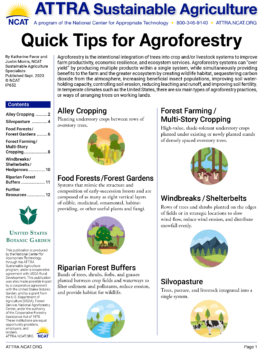Quick Tips for Agroforestry
By Katherine Favor and Justin Morris, NCAT Sustainable Agriculture Specialists
Abstract
Agroforestry is the intentional integration of trees into crop and/or livestock systems to improve farm productivity, economic resilience, and ecosystem services. Agroforestry systems can “over yield” by producing multiple products within a single system, while simultaneously providing benefits to the farm and the greater ecosystem by creating wildlife habitat, sequestering carbon dioxide from the atmosphere, increasing beneficial insect populations, improving soil water-holding capacity, controlling soil erosion, reducing leaching and runoff, and improving soil fertility. In temperate climates such as the United States, there are six main types of agroforestry practices, or ways of arranging trees on working lands.
Contents
Alley Cropping
Silvopasture
Food Forests/Forest Gardens
Forest Farming/Multi-Story Cropping
Windbreaks/Shelterbelts/Hedgerows
Riparian Forest Buffers
Further Resources
Alley Cropping
What It Is
Rows of understory crops planted between rows of overstory trees.
Species Selection
- Select trees and crops that are adapted to your site’s soil type and USDA Plant Hardiness Zone.
- Trees commonly seen in alley cropping systems include valuable hardwood veneer species, timber or lumber trees, fruit-producing species, or nut/oil producing species.
- If generating income is a priority goal, select high-value production trees with a proven market value.
-
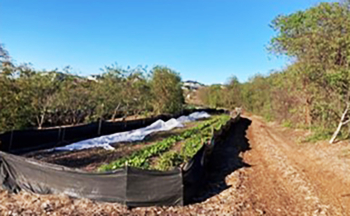
An elderberry and market garden alley cropping system in San Diego, California. Photo: Katherine Favor
Choosing native or naturalized trees can reduce reliance on inputs like water and fertilizer, while also providing habitat for wildlife, pollinators, and beneficial insects that can improve pest control.
- Selecting trees with a low “leaf area index” (i.e., low foliage density, meaning a canopy and leaf structure that allows more light to pass through) helps ensure that sufficient light reaches understory crops.
- To improve soil fertility, nitrogen-fixing trees can be planted near production trees for the first several years, and they can be removed later, once production trees are well established.
- Plan for succession. Sun-loving understory alley crops may be planted during the first few years, while tree canopies are small, but these may need to be replaced by shade-tolerant or shade-obligate understory crops when trees are large and cast more shade. Alternatively, trees can be thinned later on, to not over-shade the understory crop when they are mature.
- In general, cool-season crops can tolerate shade from trees better than warm-season crops can.
-

An avocado and coffee alley cropping system in San Diego, California. Photo: Katherine Favor, NCAT
Trees and crops paired together in alley cropping systems should have similar soil preferences, including pH, texture, and nutrient requirements.
- In crop rows closest to trees, crops may experience competition from trees for water and nutrients. To prevent this, pair crops that have shorter root systems with trees that have deeper root systems, to prevent root overlap.
- To determine which tree and crop species are best for your specific site and growing context, consult your local NRCS Service Center and local Cooperative Extension office.
Design and Management Tips
- If the landscape is sloped, orient tree rows on contour with the land to reduce erosion.
-
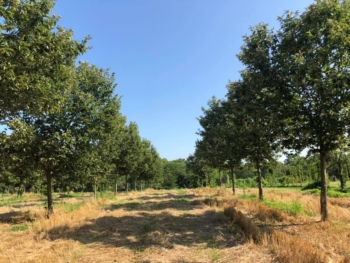
A chestnut and wheat alley cropping system in Missouri. Photo: Katherine Favor
If slope is not a factor on your landscape, orient tree rows so as to achieve even distribution of sunlight as much as possible. In regions located at latitudes farther north than 50° in the Northern Hemisphere and farther south than 50° in the Southern Hemisphere, a north-south row orientation is preferable in order to achieve more even light exposure. At latitudes between 40° in the Northern Hemisphere and 40° in the Southern Hemisphere, planting trees in east-west row orientations allows for more even distribution of light.
- For maximum production and maximum windbreak effect, space in-row trees closely together.
- Alleys should be wide enough to accommodate the equipment needed to manage the understory alley crop.
- One way to manage excessive competition between trees and understory crops for water and nutrients is to apply more fertilizer and water in the crop rows closest to trees. Alternatively, another option is “root pruning,” in which tree roots are cut with a subsoiler once a year to encourage them to grow downwards instead of outwards.
 Silvopasture
Silvopasture
What It Is
Trees, pasture, and livestock intentionally integrated into a single system.
Species Selection
- The overstory tree component may consist of:
-
- Thinned forest overstory
- Production orchards
- Timber trees, nut trees, fruit trees, or other high-value production trees planted into pasture.
- Fodder trees with a high protein and nutritional content for livestock planted into pasture
- The pasture component should consist of shade-tolerant pasture with high protein content. Cool-season grasses are common in silvopasture systems.
- The animal component could consist of one species or multiple species of animals. Cattle, sheep, horses, hogs, pastured poultry, geese, and ducks are all commonly used in silvopasture systems. Goats should be avoided in most systems, as they can climb on and damage trees.
- Select trees and crops that are adapted to your site’s soil type and USDA Plant Hardiness Zone.
- To determine which species are best for your specific site and growing context, consult your local NRCS Service Center and local Cooperative Extension office.
Design and Management Tips
-
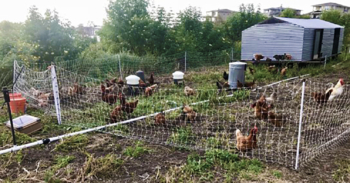
An elderberry and pastured poultry silvopasture system in San Diego, California. Photo: Katherine Favor
Establishment of silvopasture systems can occur by thinning existing overstory forest and planting pasture into it, by planting new trees into pasture, or by rotating animals under an existing orchard.
- Animals in the system should be rotated in accordance with adaptive grazing/rotational grazing principles.
- Multi-species grazing is when more than one species of animals grazes in a single area. This can involve more than one species in a paddock at the same time or a rotation of one species followed by a rotation of another species (e.g., a rotation of cattle followed by a rotation of sheep). It can be employed for improved forage utilization, increased stocking density, and improved weed and pest control.
- Trees can be spaced evenly, in rows, or in another arrangement, as long as shade is distributed relatively evenly.
-
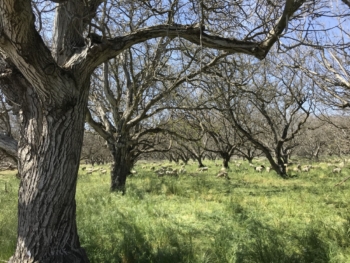
A walnut and sheep silvopasture system in Winters, California. Photo: Katherine Favor
Aim for 25 to 60% shade from overstory trees (100 to 450 trees per acre). If you don’t plan on thinning, this translates to a spacing of about 40 feet by 40 feet. If thinning is an option, tighter initial spacings are possible.
- If trees are food-producing, animals should be excluded from pastures 90 to 120 days before harvest of the food-producing trees, depending on the crop, in accordance with the Food Safety Modernization Act standards.
- If planting new trees into pasture, trees must be protected from livestock for as much as seven years while they are growing. During this time, animals may be excluded from pasture entirely and forage can be harvested for hay instead of grazed, trees may be protected from livestock with fencing, or crops may be grown under trees until they are large enough to accommodate livestock
- Prepare to install infrastructure such as fencing, irrigation, a system for providing water to animals, and shelter for animals.
- Equipment for managing silvopasture systems may include no-till drills, balers for hay, and tractors for managing hay and weeds.
 Food Forests / Forest Gardens
Food Forests / Forest Gardens
What It Is
Systems that mimic the structure and composition of early-succession forests and are composed of up to eight vertical layers of edible, medicinal, ornamental, habitat-providing, or other useful plants and fungi.
Species Selection
- Vertical layers may consist of:
- A layer of overstory or canopy-layer trees with heights of 25 to 100 feet
- An understory tree or midstory tree layer of smaller trees with heights of 7 to 25 feet
- A shrub layer of woody perennial bushes, shrubs, and brambles with heights of 3 to 10 feet
- An herbaceous crop layer below woody trees and shrubs, which can include shade-tolerant crops, herbs, medicinal plants, flowers, mushrooms, etc.
- A groundcover layer of low-lying vegetation or cover crops that protects the ground, smothers weeds, and keeps the ground moist
- A vine layer consisting of plants that climb the vertical infrastructure of trees and shrubs
- A root layer consisting of root crops
-
Select a variety of different plants that fulfill different ecological functions, with the goal of creating an ecosystem that relies on as few inputs as possible. For example:
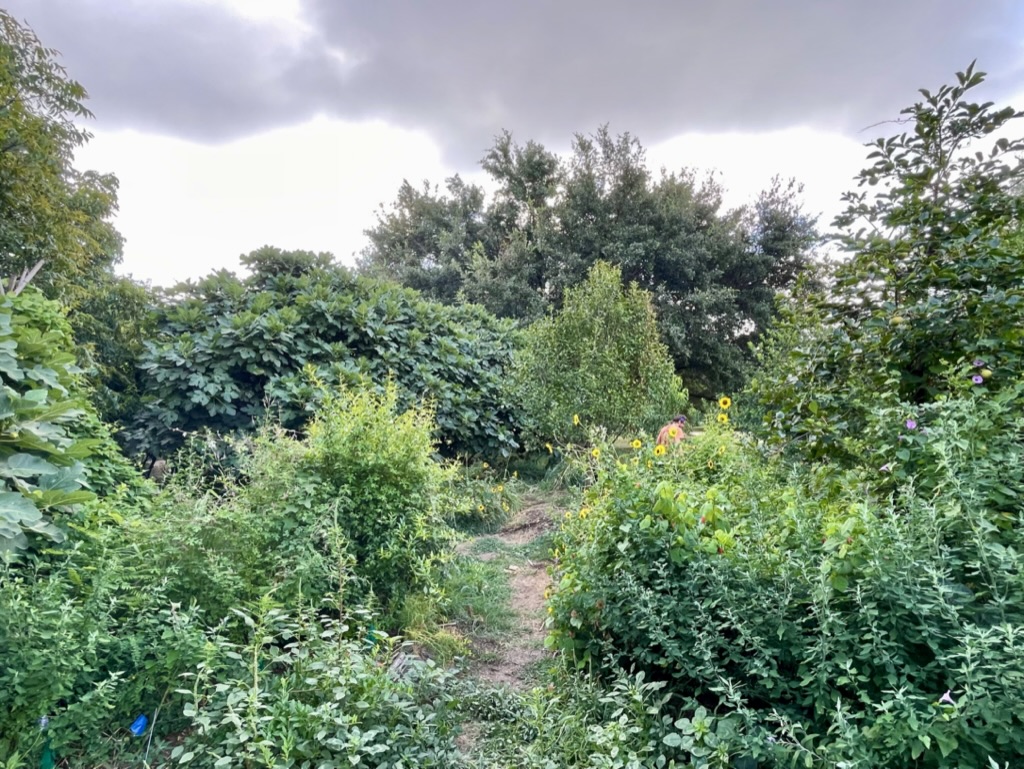
The Festival Beach Food Forest in Austin, Texas. Photo: Katherine Favor
- To improve pest control, consider selecting a range of native plants and flowering plants that attract pollinators and predatory arthropods.
- To provide habitat for wildlife, consider selecting native plants.
- To improve soil health, consider selecting nitrogen-fixing plants or nutrient-accumulating plants that draw nutrients up from deep in the soil and make them available to plants in upper soil profiles.
- To improve soil structure, select plants with different root sizes and structures, so as to break up compacted soil.
- To provide relief from extreme heat, pair understory plants with trees that provide shade.
- Select trees and crops that are adapted to your site’s soil type and USDA Plant Hardiness Zone.
- To determine which species are best for your specific site and growing context, consult your local NRCS Service Center and local Cooperative Extension office.
Design and Management Tips
- Space overstory trees, understory trees, and shrubs at sufficient distances to allow at least some light to penetrate to each layer of the understory. Lower forest garden layers can be spaced together more tightly.
- Arrange groupings of plants in complementary ways that maximize the use of resources and minimize competition. For example, pair plants with long roots with plants with short roots, to avoid competition for nutrients in the soil, or pair plants that need shade with trees that have denser canopies.
- The density and diversity of plants in forest gardens usually requires systems to be maintained with manual labor. Design the forest garden layout in a way that permits movement, efficient management, and mechanization where appropriate.
 Forest Farming / Multi-Story Cropping
Forest Farming / Multi-Story Cropping
What It Is
High-value, shade-tolerant understory crops planted under existing or newly planted stands of densely spaced overstory trees.
Species Selection
- Overstory trees may consist of planted stands of timber trees, fruit- or nut-producing orchards, or native forest.
- Understory crops can be any shade-tolerant or shade-obligate plants planted for edible, medicinal, or ornamental purposes. Common understory crops in forest farming systems include the following:
- Edible herbs such as ramps and sorrel
- Medicinal plants such as ginseng and goldenseal
- Ornamental plants and woody florals like Christmas trees and ferns
- Non-timber forest products such as firewood, wood chips, or biochar
- Fungi such as Shiitake mushrooms
-
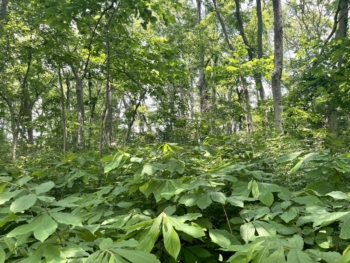
A pawpaw forest farming system with an overstory of native trees and an understory of pawpaw trees, in Nashville, Tennessee. Photo: Katherine Favor
Choose understory plants with shorter root systems to avoid competition with trees for water and nutrients.
- Select tree/crop combinations with similar pH, soil texture, and nutrient requirements.
- Select trees and crops that are adapted to your site’s soil type and USDA Plant Hardiness Zone.
- To determine which species are best for your specific site and growing context, consult your local NRCS Service Center and local Cooperative Extension office.
Design and Management Tips
- Some overstory thinning and pruning may be needed to provide sufficient light to understory crops.
- For help thinning overstory trees, contact county Extension forestry specialists, state forestry personnel, or private forest consultants through the Association of Consulting Foresters or the Society of American Foresters.
- Ensure that overstory trees are thinned so as to allow equipment to access understory plants below.
 Windbreaks/Shelterbelts/ Hedgerows
Windbreaks/Shelterbelts/ Hedgerows
What It Is
Rows of trees and shrubs planted on the edges of fields or in strategic locations to slow wind flow, prevent wind erosion, attract pollinators, and provide habitat to wildlife.
Species Selection
- Ideally, select one row of tall evergreen trees, one row of tall or short deciduous trees, and one row of shrubs for a staggered and continuous windbreak effect. Planting evergreen trees will ensure some protective vegetation year-round.
- To serve the dual purpose of providing habitat for wildlife and pollinators, select native trees and shrubs that flower at varying times of the year.
- Select trees and crops that are adapted to your site’s soil type and USDA Plant Hardiness Zone.
- To determine which species are best for your specific site and growing context, consult your local NRCS Service Center and local Cooperative Extension office.
Design and Management Tips
-

A native plant hedgerow alongside an almond orchard in California’s San Joaquin Valley. Photo: Katherine Favor
Plant one to three rows of trees and/or shrubs perpendicular to prevailing winds. Use wind rose datasets to determine prevailing wind direction.
- If planting multiple rows, space rows 8 to 10 feet apart.
- Plant trees and shrubs close enough so that there is 40 to 60% foliage density.
- Windbreak length should be at least 10 times the height of trees.
- Ensure that windbreaks are continuous and that there are no vegetation gaps.
- To establish, install weed barriers or mulch, and use drip irrigation for the first two years if precipitation is not consistent in your area.
 Riparian Forest Buffers
Riparian Forest Buffers
What It Is
Bands of trees, shrubs, forbs, and grasses planted between crop fields and waterways to filter sediment and pollutants, reduce erosion, and provide habitat for wildlife.
Species Selection
- Beginning at crop fields and moving towards streambanks, plant bands of grasses, then forbs, then shrubs and trees.
- Plant a wide variety of native and naturalized trees and plants.
- If generating income is a primary goal, select plants that provide habitat for wildlife and that also have income-generating value, such as for timber, nut, or fruit production.
- Select trees and crops that are adapted to your site’s soil type and USDA Plant Hardiness Zone.
- To determine which species are best for your specific site and growing context, consult your local NRCS Service Center and local Cooperative Extension office.
Design and Management
-
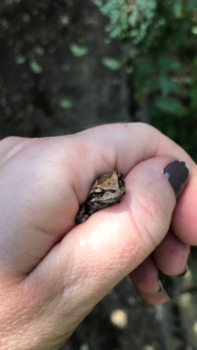
Reptiles such as frogs can be protected by riparian forest buffers. Photo: Katherine Favor
Plant bands of different types of vegetation in “zones.”
- Zone 1 is the zone nearest to the body of water, and it should be planted with trees and shrubs to stabilize the streambank and provide shade to the waterway.
- Zone 2 should consist of mostly trees and shrubs, to soak up excess nutrients from crop fields, provide habitat for wildlife, and slow down water.
- Zone 3 is the zone adjacent to crops, and it should be planted with grasses and forbs, to slow runoff, prevent erosion, and filter out toxins and nutrients from the crop fields.
- If pollutant and/or sediment filtering is a primary goal, work with NRCS to design buffer width based on field length, slope, soil texture, pollutant type, and C-factor (based on the Universal Soil Loss Equation and determined by floor-management practice employed).
- If pollutant removal is a primary goal, design buffer widths to be 1/20th the width of the upslope runoff area.
- If wildlife habitat is a primary goal, design buffers to be 10 to 600 feet wide.
- To support invertebrates, aquatic species, reptiles, birds, and small animals, buffers should be 100 to 200 feet.
- To support large mammals and predator mammals, buffers should be 300 to 600 feet.
Further Resources
ATTRA Resources
Agroforestry: An Overview
An introduction to the agroforestry practices of alley cropping, silvopasture, windbreaks, forest farming/multi-story cropping, riparian buffer strips, forest gardens, with case studies and extensive further resources.
Building Sustainable Farms, Ranches, and Communities: Federal Programs for Sustainable Agriculture, Forestry Entrepreneurship, Conservation, and Community Development
A guide addressing federal program resources in community development, sustainable land management, and value-added and diversified agriculture and forestry.
Conservation Buffers in Organic Systems
Guidance on installing conservation buffers in organic production systems in order to meet the National Organic Program (NOP) regulations, influence ecological processes, and provide a variety of services.
Episode 240. Urban Agroforestry for Dryland Environments
In this episode of Voices from the Field, NCAT Agriculture Specialist Katherine Favor talks with Christopher Marciello of Ecology Artisans — a regenerative landscape and design firm — about urban agroforestry in dryland environments.
Episode 235. Silvopasture 101
In this episode of Voices from the Field, NCAT Sustainable Agriculture Specialist Katherine Favor talks with silvopasture specialist Delie Wilkens about the basics of silvopasture, an agroforestry practice integrating trees, forage, and livestock grazing.
Hogs: Pastured or Forested Production
This publication touches on factors to consider before beginning a pastured pork enterprise.
Urban Agroforestry Tipsheet: Food Forests and Beyond
Information about agroforestry in urban areas, including tips for how to plan, design, establish and maintain urban agroforestry systems.
Other Resources
AgBuffer Builder
This GIS-based tool for water quality helps design more effective buffers.
Conservation Buffers: Design Guidelines for Buffers, Corridors, and Greenways
This book offers design guidelines for multipurpose buffers.
A Practical Field Guide for Designing Conservation Buffers
A webinar with guidelines for designing vegetative buffers, with guidelines for ways that buffers can be applied to protect soil, improve air and water quality, enhance fish and wildlife habitat, produce economic products, provide recreation opportunities, or beautify the landscape.
Windbreak Economic Model
This Microsoft Excel-based tool can be used to analyze the costs and benefits of a windbreak that you design.
Wind Rose Data Set
A dataset of wind rose plot images in .gif format, organized by state, city within each state, and month of the year. The wind roses are based on hourly data from NOAA’s Solar and Meteorological Surface Observation Network (SAMSON) dataset.
Quick Tips for Agroforestry
By Katherine Favor, NCAT Agroforestry Specialist, and Justin Morris, NCAT Sustainable Agriculture Specialist
Published September 2023
© NCAT
IP652
This publication is produced by the National Center for Appropriate Technology through the ATTRA Sustainable Agriculture program, under a cooperative agreement with USDA Rural Development. This publication was also made possible in part by a cooperative agreement with the United States Botanic Garden, and by a grant from the U.S. Department of Agriculture (USDA), Forest Service, National Agroforestry Center, under the authority of the Cooperative Forestry Assistance Act of 1978. These institutions are equal opportunity providers, employers, and lenders. ATTRA.NCAT.ORG.



